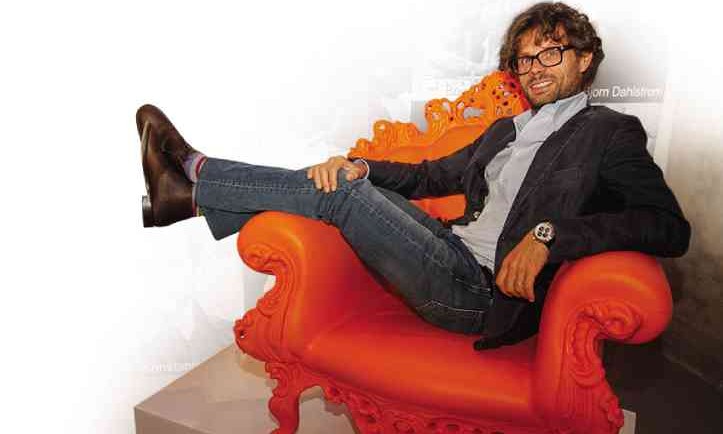
As a manufacturer of modern furniture and accent pieces designed by some of the world’s most famous names such as Philippe Starck, Jasper Morrison and Tom Dixon, Magis has produced around 40 types of chairs that have found their way to more than 80 countries, including the Philippines.
But, as Alberto Perazza said, it wasn’t simply a matter of beefing up Magis’ product line up. Although Magis is Latin for “more,” there must be a story behind every product that comes out from its subcontractors’ factories in and around Treviso, Italy.
“We’re motivated to do a product not because there’s a need to do a new chair,” he said. “Actually, there’s too much of everything available in the market these days. Since we’re a technology-driven company, there should be a story behind every new product.”
He explained the innovation could be a combination of materials done in an unusual way, or the use of an existing technology that has never been employed before in making a chair, table or accent piece.
As partner in charge of sales and marketing, Perazza recently visited the Philippines to renew Magis’ ties with Dimensione, the brand’s exclusive Philippine distributor for over a decade now, and oversee a traveling exhibit dubbed “Made in Magis: Materials and Technologies Behind the Products.”
Composed of three sets of pictures and installations showing a progression of how Chair_One by Konstantin Grcic, Paso Doble by Stefano Giovannoni, and Steelwood by Ronan and Erwan Bouroullec are made, the exhibit was initially displayed two weeks ago at the basement of Bench Tower in Bonifacio Global City.
Asia first
Over the next three weeks, Dimensione’s flagship store at Bonifacio High Street will be highlighting the technology behind each of this iconic Magis chairs by displaying an installation every week. The exhibit at the Dimensione store is open to the public.
The exhibit debuted in Shanghai, then was staged in Taipei before Manila. Perazza has yet to announce its next destination, but Magis fans in Europe and North America will have to wait. The brand has chosen to prioritize Asia for good reason. Demand for its products in the region has grown dramatically over the years.
“I don’t have the exact number, but I think we now have more than 40 chairs,” he said, “but there’s more to us than chairs. We also do tables, home accessories and even kids’ furniture called Me Too. They’re not just miniature versions of their parents’ pieces. That would have been too lazy. Me Too offers totally new designs aimed at kids.”
But Magis will always be identified with chairs. Apart from tapping some of the world’s most celebrated designers, the brand’s production team has come up with some of the most iconic pieces using cutting-edge technology. It has done this without running a single factory.
Cebu partner
Since its inception in 1976, Magis has been “factory-free.” But “99 percent” of its products, said Perazza, are produced in Italy. The remaining one percent, in the form of the wicker-back Cyborg chair, by Marcel Wanders, comes from a “world-class” factory in Cebu.
“We went to Cebu primarily because of cost,” he said. “There’s a district in Italy not far from where we are that produces wicker pieces. But, apart from the high cost, it has become unsustainable because not enough young people want to continue the craft.”
While Magis was contemplating whether or not to continue producing the wicker-back version of the Cyborg chair two years ago (the plastic and leather versions are still done in Italy), they received good news from their regional sales and promotions manager in Hong Kong, who pointed to a company in Cebu that also supplies furniture pieces to other European brands.
“We went with the manager’s suggestion, and that was the start,” said Perazza. “So far, we’ve been happy with the results. The quality is world-class and they’re able to meet deadlines. We didn’t even consider companies in other countries in the region.”
The possibility of being copied, especially in the case of a product done thousands of miles away from Italy, will always be there. But Magis has had little reason not to trust its Cebu partners.
“We’re lucky to have a dependable and reliable partner in Cebu with a good track record,” said Perazza.
Dangers of outsourcing
Being victimized by Asian copycats is no longer news to Magis. Its adjustable plastic-and-steel Bombo chair also by Giovannoni, continues to suffer from poor sales in Asia and the US due to cheap imitations.
It’s a risk the company has to take since it decided to let others piece together its products. Although Magis still does the molds to manufacture its pieces, production is contracted to a network of various factories and suppliers.
“Since we don’t do things in-house, we coordinate with designers and production people until the product undergoes production,” said Perazza. “We try to practice and grow the relationship with one supplier per technology, or one supplier per material.”
Magis also values its relations with various designers, but none of them is given “carte blanche” access. Magis makes it a point to get involved in the entire process not so much to scrimp on cost or ensure that its investment is well spent. It simply believes that a good product is the result of a combination of many factors.
One factor is open dialogue with designers, said Perazza. “In the end, if the product fails in the market, it’s always the fault of the company, not the designer. The decision is always ours alone whether or not to go ahead with a product.”